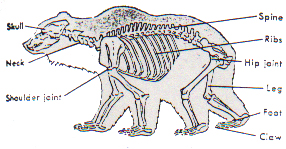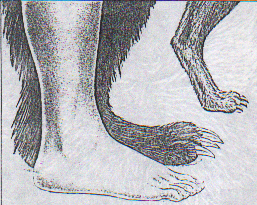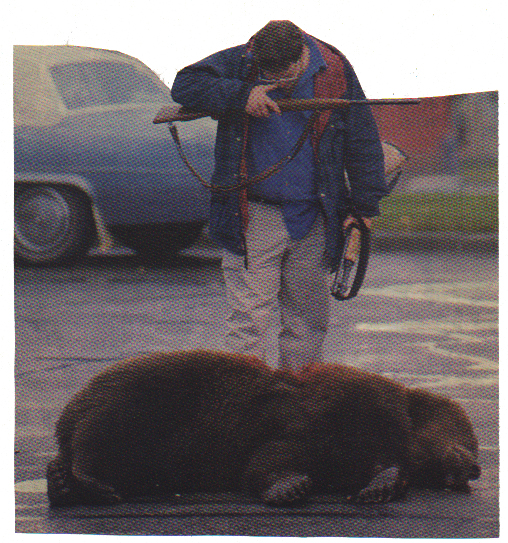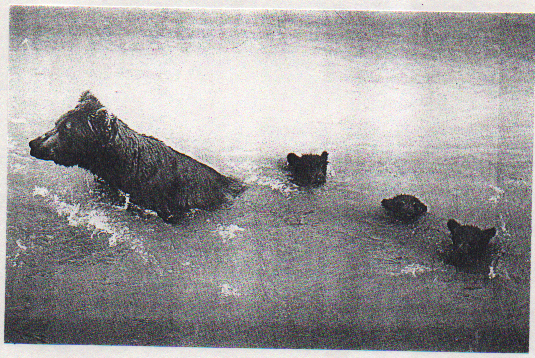 Marshall
Cultural Atlas Marshall
Cultural Atlas
This collection of student work is from
Frank Keim's classes. He has wanted to share these works for others
to use as an example of Culturally-based curriculum and documentation. These
documents have been OCR-scanned. These are available
for educational use only.
The Body of a Grizzly Bear
The Grizzly bear lives all over Alaska and in some parts of Canada
and Montana. The biggest Grizzlies live in Alaska and they can be the
most dangerous animals.
The bear's body looks very large in size because of it s loose
skin. Its large head also makes the bear look very large. Bears' eyes
are very small, and they cannot see very well. Although they have
small ears, they can hear very well and they can also smell very
well. That is why you have to watch your fish over the summer so the
bears can't get to them.
The bear's legs are very short, strong and they also have big
feet. So if you are running from a bear you'd better watch out
because if the bear swings its arms it could kill you in an instant.
The bear has four pair of legs and the five toes on each paw have
long, heavy claws. The bear uses its claws to dig out a den,for food,
and to tear its prey. The claws in the front are longer than those on
the back feet. The claws on a large bear could be as much as 6 inches
long. They do not retract into sheaths like those of Black bears.
The bear's walk is very different from that of other kinds of
animals. Most animals walk and run on their toes, but the bear puts
its whole foot on the ground. The bear usually moves very slowly and
drags its feet. The hind feet of a bear are 12 to 16 inches long.
The bear's teeth are very large. They eat both plants and meat and
are called omnivores. Their teeth are made to eat plants and meat.
Most bears eat both meat throughout the year, but three-four month
olds only eat plants. The front teeth are large canine and smaller
incisors. They are used for catching and killing the prey. The back
teeth are called molars. They are flat and used for chewing and
grinding the food.
The bear's skeleton looks more like that of a dog. That is why
they are related to the dogs, wolves, and foxes. The only difference
between the bones of a bear and a dog is the weight. Here is a
picture below that shows you the skeleton of a grizzly bear.
Skeleton of a Grizzly Bear

On the next page is a picture showing you how big bear may look.
You can see what makes the bear look so large. The head, thick layer
of skin and fur makes him look mean and vicious.

Bears are very strong and that is why they are considered
a
predator. In fact, they are one of the strongest and fastest animals
in the world. They are fast enough to catch a horse and can run up to
35 miles an hour. They grow about nine feet long and weigh over 1,500
pounds.
The body of a bear is fascinating. And the bigger the bear the
more interesting it is. I think it is the most interesting animal in
the world. It has the body of a beast and the mind of a king.
By: Tina Papp

References:
The World Book Encyclopedia, 1985
Zoobook, "'Bears". Kitson, Kenneth. 1991
 
Bear Fire
Stories and Poems
about Bears
|
by Marshall High School
Language Arts Classes
Spring, 1992
Produced
by
Information
about Bears
Creative
Stories from the Imagination
True
Stories from Experience
Poems
Christmastime Tales
Stories real and imaginary about Christmas, Slavik, and the New Year
Winter, 1996 |
Christmastime Tales II
Stories about Christmas, Slavik, and the New Year
Winter, 1998 |
Christmastime Tales III
Stories about Christmas, Slavik, and the New Year
Winter, 2000 |
| Summer Time Tails 1992 |
Summertime Tails II 1993 |
Summertime Tails III |
| Summertime Tails IV Fall, 1995 |
Summertime Tails V Fall, 1996 |
Summertime Tails VI Fall, 1997 |
| Summertime Tails VII Fall, 1999 |
Signs of the Times November 1996 |
Creative Stories From Creative Imaginations |
| Mustang Mind Manglers - Stories of the Far Out,
the Frightening and the Fantastic 1993 |
Yupik Gourmet - A Book of
Recipes |
|
| M&M Monthly |
|
|
| Happy Moose Hunting! September Edition 1997 |
Happy Easter! March/April 1998 |
Merry Christmas December Edition 1997 |
| Happy Valentine’s
Day! February Edition
1998 |
Happy Easter! March/April Edition 2000 |
Happy Thanksgiving Nov. Edition, 1997 |
| Happy Halloween October 1997 Edition |
Edible and Useful Plants of Scammon
Bay |
Edible Plants of Hooper Bay 1981 |
| The Flowers of Scammon Bay Alaska |
Poems of Hooper Bay |
Scammon Bay (Upward Bound Students) |
| Family Trees and the Buzzy Lord |
It takes a Village - A guide for parents May 1997 |
People in Our Community |
| Buildings and Personalities of
Marshall |
Marshall Village PROFILE |
Qigeckalleq Pellullermeng ‘A
Glimpse of the Past’ |
| Raven’s
Stories Spring 1995 |
Bird Stories from Scammon Bay |
The Sea Around Us |
| Ellamyua - The Great Weather - Stories about the
Weather Spring 1996 |
Moose Fire - Stories and Poems about Moose November,
1998 |
Bears Bees and Bald Eagles Winter 1992-1993 |
| Fish Fire and Water - Stories about fish, global warming
and the future November, 1997 |
Wolf Fire - Stories and Poems about Wolves |
Bear Fire - Stories and Poems about Bears Spring,
1992 |
|